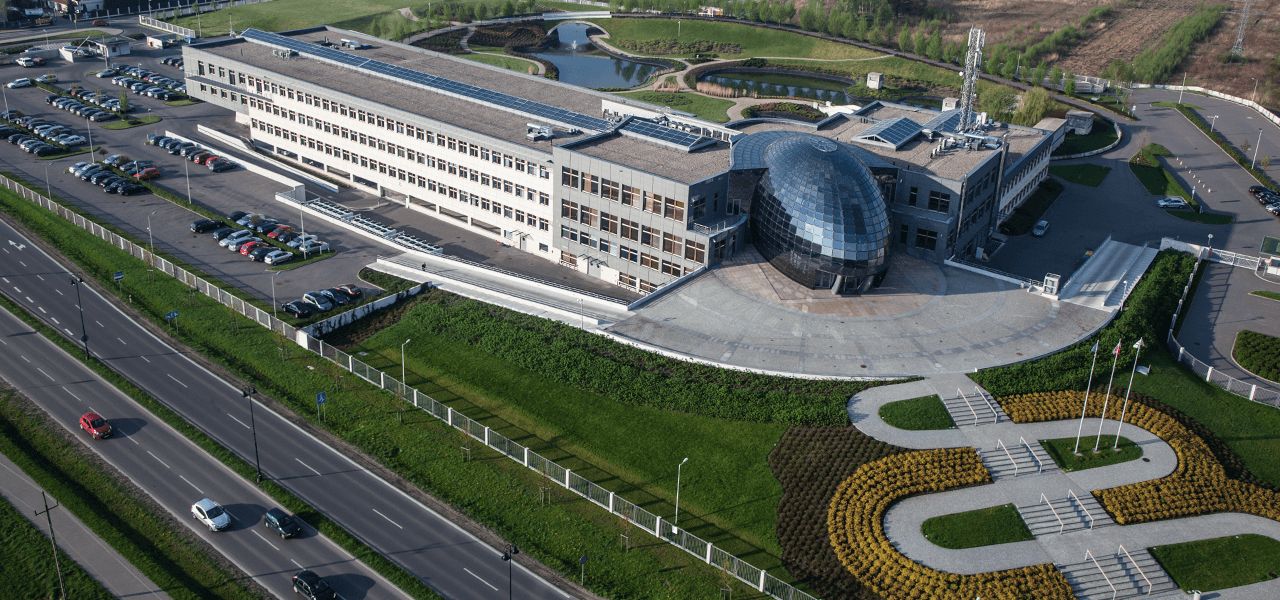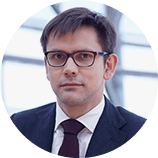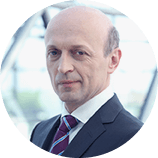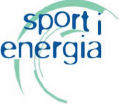3 Our company
As a transmission system operator, we play a key role in the Polish economy.
We are aware of our impact on the environment. We feel responsible for future generations.
We are implementing a new business strategy to develop our business in an integrated way.
Description of the electricity sector
Ensuring common access to electricity requires an efficiently operating system for its generation, transmission and distribution. All equipment connected to it, including consumer facilities, form the Polish Power System.
Electric energy supplied to our homes is generated mainly in power plants and combined heat and power (CHP) plants. In Poland, the basic energy generating sources are thermal power plants in which energy is generated as a result of combustion – usually by burning hard coal or lignite. The largest cluster of those plants is situated in the southern part of the country. In large cities, CHP plants operate which are mostly fired with coal, but also natural gas. Renewable energy sources (RES) are also developing: wind, hydro, biomass and photovoltaic.
Energy transmission from power plants to consumers is possible over an extensive network of power lines and electrical substations. Different voltage levels are used to optimise costs, depending on the distance over which electricity is transmitted.
The following voltage standards are adopted in Poland for electricity transmission
(extra-high voltages)
for long-distance transmission.
(high voltage)
for transmission over distances not exceeding several dozens of kilometres.
(medium voltage)
used in local distribution networks.
(low voltage)
used basically to supply power to end consumers.
The Polish power system is interconnected with the systems of neighbouring countries by cross-border lines. Currently almost all systems of Continental Europe are interconnected. They form the world's largest synchronous system.
This allows many measurable benefits to be achieved, such as:
- mutually profitable international commercial exchange,
- reduction of the required power reserve in the system,
- ability to use assistance in emergency situations.
Learn the process of electricity transmission from its generation to delivery to the consumer
- Power plants produce energy, supplying it mostly to the transmission network (400 and 220 kV) or the distribution network (110kV).
- EHV (extra-high voltage) transmission lines – 220 and 400 kV – carry energy to EHV/HV (extra-high voltage/ high-voltage) substations where voltage is transformed to 110 kV.
- HV (high-voltage) lines – 110 kV – carry energy over distances not exceeding several dozens of kilometres to HV/MV (high-voltage/medium-voltage) substations.
- MV (medium-voltage) lines – 6, 10, 15, 20 or 30 kV – carry energy to MV/LV (medium-voltage/low-voltage) substations.
- LV (low-voltage) lines – 230/400 V – carry energy to end consumers, e.g. households.
-
1
1
Generating sources
-
2
2
Power plant and MV/EHV substation
-
3
3
EHV transmission lines – PSE
-
4
4
EHV/HV transformer substation
-
5
5
HV line
-
6
6
HV/MV transformer substation
-
7
7
Pole-mounted transformer substation MV/LV
-
8
8
LV line
PSE as a transmission system operator
Electric power transmission systems are territorially extensive and technologically complicated engineering systems which require the presence of a central operator.
GRI 102-6, GRI 102-4, GRI 103Within the territory of Poland, PSE is the only transmission system operator (TSO), designated by the President of the Energy Regulatory Office (ERO) to serve this function. We provide electricity transmission and power system access services while maintaining the required criteria for the operational security of the Polish power system (PPS).
Operating rules of the transmission system operator in Poland
Our core duties are prescribed by the Energy Law and regulations issued under it by the minister in charge of energy. They define both our tasks and the way of financing them, and the applicable technical standards and dependability criteria. The costs of the tasks we perform are regulated costs. They are covered by transmission charges paid by users of the transmission system in accordance with a tariff approved by the President of ERO.
As an operator, we perform our tasks using technical facilities of transmission-connected parties – they are required to provide access to them under the applicable laws or relevant civil-law agreements.
PSE's tasks as a Transmission System Operator
GRI 102-2Tasks performed by PSE as transmission system operator can be classified into four basic groups

Quality and current security of electricity supply

Adequacy of the national transmission network

Operation of the national electricity market

International cooperation
Within interconnected power systems and the single European electricity market.
Tasks related to the quality and current security of supply
The regulatory framework applicable to the transmission system operator defines the technical standards for the transmission system operation and technical measures that should be available to it to meet the requirements in this area.
Presented below are the main tasks we perform in this area.
Balancing, i.e. striking a balance between the generation of electricity and its actual consumption
Balancing concerns both very short periods (seconds) and very long ones (hours), and it is performed by using power reserves maintained especially for this purpose. The transmission system operator is required to maintain specific amounts of second, minute and hourly reserves. The first two reserve types are acquired by PSE by entering into relevant contracts with generators for so-called regulation ancillary services – this action is preceded by a tendering procedure. The source of the hourly reserve is the balancing market (commercial bids). Depending on type and location, reserves are activated automatically or remotely, from the central power regulator, based on an order communicated by telephone or in another previously agreed way.
Ensuring compliance with network operation security criteria
The transmission system operator is required to plan network operation and generation distribution in its nodes so that a criterion distortion does not cause a system failure and constraints in energy supply to consumers. For this purpose, the TSO prepares coordination plans spanning periods of 3 years to one day. They include both maintenance schedules for network elements and repair schedules for generating units. In the planning process, constraints in the operation of generating units are identified for individual network nodes. The operator manages those constraints by using the balancing market mechanism or by entering into relevant agreements with generators.
Using automation systems, especially those of a preventive and recovery nature, and preparation of the PPS defence and restoration plans
The transmission system operator prepares measures to prevent the occurrence of states that pose a risk to the stable operation of the PPS, in particular the propagation of a failure in the transmission system. These are different kinds of automatic protection systems that support quick changes of the network operation configuration and the production level of generating units, plans of consumer outage or reduction of electricity supply and consumption, e.g. based on power rationing levels communicated by radio. In the event of a failure in the transmission system, the transmission system operator has restoration scenarios prepared, which provide, in an extreme case, for the need to restore the entire national system. In order to enable such scenarios to be executed, the system operator enters into contracts with generators capable of starting up without external power supply (ancillary service).
Tasks related to the adequacy of the national transmission network
As transmission system operator, PSE is responsible for the expansion and maintenance of the national transmission grid and its interconnections with the neighbouring countries' systems. To ensure network adequacy, PSE performs the tasks mentioned below.
Planning the expansion
Planning the expansion of the transmission network which takes into account the expected changes in the value and geographical distribution of domestic demand, location of new generating sources and network expansion plans of the operators of neighbouring countries and distribution system operators.
Maintenance of the physical condition
Maintenance of the physical condition of network resources so as to ensure their high availability.

Tasks related to the operation of the national electricity market
Due to the special nature of electricity as a product, there must be a central balancing mechanism as well as party responsible for balancing. The mechanism is to ensure the commercial balancing of electricity market participants in real time and settlement of balancing energy. In Poland, this role is played by the balancing market mechanism through which current balancing of energy market participants is performed on the basis of bids submitted by parties actively participating in the market. It has a very strong impact on other segments of the energy market as well as decisions on how generating resources should be used.
The balancing market operation rules should ensure:
- equal treatment of all participants,
- transparency of the calculation of clearing prices,
- the possibility of consumer participation (consumption reduction bids),
- creation of price signals conducive to the improvement of the operational performance of the entire sector.
International cooperation tasks
We are a member of the European Network of Transmission System Operators for Electricity - (ENTSO-E). ENTSO-E groups together 43 transmission system operators from 36 countries.
The organisation has been in existence since December 2008, and since 3 March 2011 it has been operating under Regulation (EC) No 714/2009 of the European Parliament and of the Council of 13 July 2009 on conditions for access to the network for cross-border exchanges in electricity and repealing Regulation (EC) No 1228/2003.
What is the purpose of the organisation? The task of ENTSO-E is to promote reliable operation, optimal management and sustainable development of the pan-European electric power transmission system to ensure the security of supply and satisfy the needs of the internal energy market.
More than 60 employees of PSE are engaged in the work of ENTSO-E, actively participating at different organisation levels in all key tasks including, among other things, the process of preparing European network codes, issued as regulations of the European Commission, and guidelines. Network codes are specific tools for the implementation of the single electricity market in the EU. They lay down common rules for the operation and management of power systems and are aimed to eliminate technical barriers for further integration of the market.

Description of European regulations and their impact on the operation of the Polish electricity market and PSE's activities
Presented below are the key legislative acts of the European Union implemented into national legislation, which influence the activities of the TSO
Directive 2009/72/EC of the European Parliament and of the Council of 13 July 2009
concerning common rules for the internal market in electricity and repealing Directive 2003/54/EC – sets out the main obligations of the TSO and the rules for the effective unbundling of electricity generation and supply activities from transmission activities, thus the obligations of TSO ownership unbundling.
Directive 2009/28/EC of the European Parliament and of the Council of 23 April 2009
on the promotion of the use of energy from renewable sources and amending and subsequently repealing Directives 2001/77/EC and 2003/30/EC – establishes a common framework of measures aimed to ensure a 20 percent share of RES in final consumption of energy, including the rules for priority treatment of renewable sources in the network connection process.
Directive 2005/89/EC of the European Parliament and of the Council of 18 January 2006
concerning measures to safeguard security of electricity supply and infrastructure investment – sets out measures aimed to guarantee the security of electricity supply in order to ensure the correct operation of the internal electricity market.
The key EU regulations directly applicable in Poland, which influence the TSO's activities
Regulation (EC) No 714/2009 of the European Parliament and of the Council of 13 July 2009
on conditions for access to the network for cross-border exchanges in electricity and repealing Regulation (EC) No 1228/2003 –
Regulation (EC) No 713/2009 of the European Parliament and of the Council of 13 July 2009
establishing an Agency for the Cooperation of Energy Regulators (ACER) – sets forth the tasks, powers and operation principles of ACER.
Regulation (EU) No 1227/2011 of the European Parliament and of the Council of 25 October 2011
on wholesale energy market integrity and transparency(REMIT) – sets out the legal framework for monitoring wholesale energy markets,
Commission Implementing Regulation (EU) No 1348/2014 of 17 December 2014
on data reporting implementing Article 8(2) and Article 8(6) of Regulation (EU) No 1227/2011
Commission Regulation (EU) No 543/2013 of 14 June 2013
on submission and publication of data in electricity markets and amending Annex I to Regulation (EC) No 714/2009
Commission regulations establishing guidelines and network codes, which are tools for the implementation of the single electricity market in the EU, are an important part of the EU regulatory framework affecting the operation of the Polish power system and the TSO's activities. They lay down common rules for the operation and management of power systems and are aimed to eliminate technical barriers for further integration of the European electricity market.
List of regulations published by the Commission
Commission Regulation (EU) 2015/1222 of 24 July 2015
establishing a guideline on capacity allocation and congestion management.
Commission Regulation (EU) 2016/631 of 14 April 2016
establishing a network code on requirements for grid connection of generators.
Commission Regulation (EU) 2016/1388 of 17 August 2016
establishing a network code on demand connection.
Commission Regulation (EU) 2016/1447 of 26 August 2016
establishing a network code on requirements for grid connection of high voltage direct current systems and direct current-connected power park modules.
Commission Regulation (EU) 2016/1719 of 26 September 2016
establishing a guideline on forward allocation.
Commission Regulation (EU) 2017/1485 of 2 August 2017
establishing a guideline on electricity transmission system operation.
How we operate
GRI 102-1, GRI 102-5
We operate throughout the country under the name of Polskie Sieci Elektroenergetyczne Spółka Akcyjna (PSE S.A.).
100%
stake held by the State Treasury
Network infrastructure
Services
35
Number of transmission agreements with entities connected to the transmission network
87
Number of transmission agreements with entities operating in the electricity balancing market, not connected to the transmission grid
157
Number of PPS access service agreements with DSOs not connected to the transmission network
46
Number of concluded agreements for the connection of new sources to the transmission grid
27
Number of connection agreements for new generating sources for which PSE has launched investment projects involving works necessary for connection
*Data refer to the year 2016.
Financial results
|
2016 financial data (in PLN '000s) | |
|---|---|
|
EBIT (operating profit) |
648 077 |
|
Depreciation |
611 980 |
|
EBITDA |
1 260 057 |
|
Liabilities and provisions for liabilities |
4 821 550 |
|
Total assets |
18 465 609 |
|
Debt ratio |
0,26 |
|
Net profit |
568 379 |
|
Shareholders' equity |
13 644 059 |
|
ROE (%) |
4,17 |
PSE Capital Group
GRI 102-45

Polskie Sieci Elektroenergetyczne S.A.*

PSE Inwestycje S.A.
A specialised company responsible for design work and the organisation and supervision of the implementation of investment projects related to the construction, expansion and upgrading of buildings for the purposes of welfare/ office and technical facilities of the PSE S.A. transmission system.
100 percent PSE share in share capital

PSE Innowacje Sp. z o.o.
An entity that provides consulting services which involve analysis, research, new technologies and IT solutions in the power sector, in particular supporting PSE in implementing new technologies, as well as innovation, research and development work ensuring the secure and cost-effective operation of the PPS.
100 percent PSE share in share capital

LitPol Link Sp. z o.o.
The company coordinated work under the Poland-Lithuania interconnection project completed in 2015, with regard to the cross-border section of the project. It included the construction of a 400 kV two-circuit overhead line linking the power systems of Lithuania and Poland between the Alytus and Ełk Bis substations, construction of a converter station in Alytus and conversion of the Alytus and Ełk Bis substations

Joint Allocation Office S.A.
A company established by 20 TSOs from the CEE and CWE regions and Norway through a merger of the auction offices Central Allocation Office GmbH and Capacity Allocation Service Company.eu S.A.
The purpose for which JAO was set up was to provide the highest quality of services to customers and shareholders while ensuring the maximum economic performance and meeting the EU requirements for constraint management.

TSCNET Services GmbH
A development initiative of TSC covering a large part of the Continental Europe synchronous area.
TSC's business objective – to improve the operational security of interconnected power systems (including the PPS) – is fully consistent with European regulations and the single European electricity market being created.
In order to improve inter-TSO cooperation within TSC, 10 TSOs established the company TSCNET Services GmbH (hereinafter: TSCNET)
based in Munich.
*Grupę Kapitałową PSE tworzą Polskie Sieci Elektroenergetyczne S.A. – spółka dominująca.
The company has its field units in Bydgoszcz, Katowice, Poznań, Radom and Warsaw.
Economic performance
We implement our strategic objectives, continuously monitoring our performance and the achievement of key economic and financial indicators. Preparing mid-term projects that make it possible to assess the capability to finance the expenditure adopted in the Investment Plan, assuming full implementation of strategic objectives and operations.
|
GRI 201-1 Direct economic value generated taking into account income, operating costs, employee remuneration, subsidies and other investments for the community, undistributed profits, and payments to capital owners and state institutions |
Values (in PLN) | |
|---|---|---|
|
2016 |
2015 | |
|
Net sales |
8 144 476 446 |
7 623 542 968 |
|
Other operating income |
57 670 908 |
91 283 530 |
|
Financial income |
61 670 693 |
60 852 653 |
|
Extraordinary profits |
0 |
0 |
|
Income (all income and profits included in the financial statements) |
8 263 818 047 |
7 775 679 151 |
|
Operating costs |
7 366 224 742 |
6 812 160 875 |
|
Other operating costs |
187 845 518 |
30 352 233 |
|
Financial costs |
4 079 601 |
785 681 |
|
Operating costs, including: |
7 558 149 861 |
6 843 298 789 |
|
Payroll, social security and other benefits |
335 856 288 |
318 203 336 |
|
Taxes and charges |
242 732 246 |
236 401 426 |
|
Investment in communities* |
61 182 |
93 000 |
|
Interest expense |
477 894 |
341 253 |
|
Operating costs (taking into account the exclusions shown above) |
6 979 022 251 |
6 288 259 774 |
|
Payroll, social security and other benefits |
335 856 288 |
318 203 336 |
|
Dividend |
0 |
0 |
|
Payments to investors |
0 |
0 |
|
Taxes and charges |
242 732 246 |
236 401 426 |
|
Income tax, current part |
160 669 928 |
196 677 905 |
|
Profit payment |
81 793 617 |
110 372 274 |
|
Payments to the state |
485 195 791 |
543 451 605 |
|
Investment in communities* |
61 182 |
93 000 |
|
Retained value |
463 682 535 |
625 671 436 |
*We carry on a regulated activity, generating our core income from the transmission tariff approved by the President of ERO. In practice, this means that we have limited capabilities to develop social engagement programmes, in particular by making donations to public benefit organisations and other organisations, which influences the scale of investment in communities.
Membership of organisations
The position of PSE and the responsibility lying on our company oblige us to share our knowledge and experience. Our experts' opinions provide substantive support to legislative initiatives and the law-making process, as well as to industry projects and scientific conferences. The platform for cooperation and opinion exchange are national and international organisations and associations.
Building an internal electricity energy market, PSE undertakes a range of activities in the European market – including as a member of the European Network of Transmission System Operators for Electricity (ENTSO-E).
Governing bodies of ENTSO-E

Eryk Kłossowski
President of the Management Board of PSE,
is PSE's Representative
to the Assembly of ENTSO-E.

Tomasz Sikorski
Vice President of the Management Board of PSE,
is a member of the Board of ENTSO-E.

Konrad Purchała
Deputy Director for European Integration Strategy
International Cooperation Department,
is the Chair of the Market Committee of ENTSO-E.
GRI 102-12, GRI 102-13
Learn about international and national industry and CRS organisations of which PSE is a member

ENTSO-E
European Network of Transmission System Operators for Electricity, an important link in building a common electricity market. ENTSO-E prepares so-called network codes which form a basis of the EU law.

Central Europe Energy Partners (CEEP)
an international non-profit association representing the Central European energy sector, whose objective is to support the integration of the Central European energy sector within the framework of the EU common energy and security policy in the area.

Association of Polish Electrical Engineers (SEP)
a creative non-governmental organisation of a scientific and technical nature operating for social and public benefit. It is a voluntary association of electrical engineers of all specialties, whose professional activities are related to broad-based electrical engineering, as well as legal persons with an interest in its activities.

Polish Committee for Large Electric Systems (PKWSE
one of 58 national committees operating on behalf of CIGRE, the world's largest international association of experts dealing with the issue of power generation, transmission and distribution.

Polish Power Transmission and Distribution Association (PTPiREE)
an organisation whose main object is to take measures towards comprehensive development and rational use of networks and facilities for the transmission and distribution of electricity.

Towarzystwo Turystyczno-Sportowe „Sport i Energia”
a nationwide tourism and sport association based in Konstancin-Jeziorna.

Responsible Energy
an initiative that groups together socially responsible companies from the energy sector. Its main idea is to increase the awareness of the importance of sustainable development and popularise good practices among representatives of the energy sector, students, and representatives of the administration and NGOs.